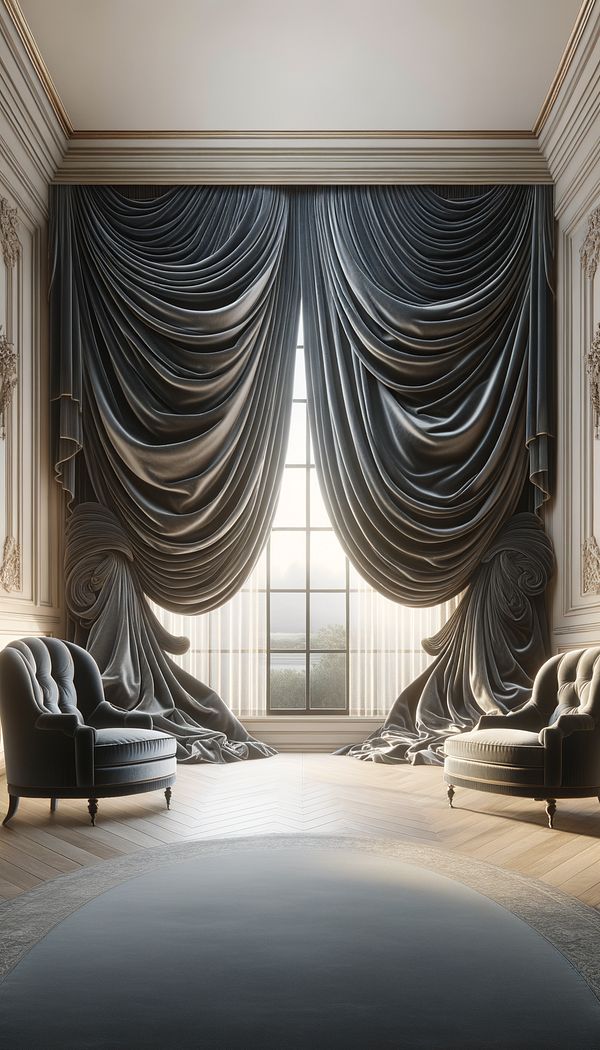What is a Bishop’s Sleeve?
A type of curtain design that resembles the flowing sleeves of a bishop's robe.
Description
A Bishop’s Sleeve refers to a distinctive style of drapery or curtain that takes its inspiration from the flowing, full sleeves of a traditional bishop's robe. This design features fabric that is generously gathered or pleated at the top to create a series of soft, billowing folds that then taper to a fitted or tied section, mimicking the appearance of a sleeve. The bottom of the curtain may be allowed to pool gracefully on the floor, adding to its luxurious and voluminous effect.
This type of window treatment adds a dramatic and elegant touch to interiors, blending well with various decorative styles and settings. Bishop’s Sleeves are particularly popular in formal living rooms, bedrooms, and dining areas, where they complement traditional and classical aesthetics. However, with varying lengths and fabrics, they can also be adapted to suit contemporary spaces. The choice of fabric is crucial in achieving the desired look, with lighter materials emphasizing the delicate folds and heavier fabrics offering a more opulent feel.
Aside from its visual appeal, the Bishop’s Sleeve also serves practical purposes, such as enhancing privacy and controlling light. When paired with a functional window treatment like blinds or shades, it combines functionality with a high level of decorative flair.
Usage
In a classic Victorian-style living room, Bishop's Sleeve curtains made from luxurious velvet can be used to frame large windows, adding an air of grandeur and historic elegance to the space. This design can also be found in contemporary settings, where sheer or lighter fabrics are used to create a breezy, ethereal look that softly diffuses light.
FAQs
-
Can Bishop’s Sleeves be used in modern interiors?
Yes, Bishop’s Sleeves can be adapted for modern interiors by choosing fabrics with a lighter weight and simpler texture, as well as by opting for a less voluminous gather. This creates a softer, more understated look that blends well with contemporary design elements.
-
Are Bishop’s Sleeves suitable for all window sizes?
Bishop’s Sleeves can be customized to fit various window sizes, but the fullness and dramatic effect are best showcased on larger windows. For smaller windows, a reduced volume of fabric and fewer gathers may be necessary to maintain proportion and balance.
-
How are Bishop’s Sleeves maintained?
Maintenance of Bishop’s Sleeves depends on the fabric used. Many can be carefully vacuumed or lightly dusted, while others may require professional cleaning. It’s important to follow care instructions specific to the fabric to keep the curtains looking their best.
Practical Application
To incorporate Bishop’s Sleeves into your interior, start by selecting a fabric that complements the overall design aesthetic of the room. Consider the weight and texture of the material as well as how it will interact with light. Next, measure the window to determine the required length and volume of fabric, ensuring that there will be enough material to create the full, flowing effect. Finally, consider whether you’d like the bottom of the curtains to pool on the floor for an added touch of elegance, or to have them just skim the floor for a cleaner look.
-
Window Treatments65 articles
-
Decorating Principles & Elements330 articles
-
Textiles & Upholstery252 articles
-
PastelsPastels refer to soft, light colors used in interior design.
-
ChevronChevron is a V-shaped pattern used in various design aspects.
-
Roll-Top DeskA roll-top desk is a type of desk characterized by a flexible, sliding, tambour door that rolls up to expose the work surface and compartments.
-
Platform BedA low-profile bed frame with a solid or slated base designed to support a mattress without the need for a box spring.
-
Leather FinishingLeather finishing refers to the processes applied to the surface of the leather to enhance its appearance, feel, durability, and resistance to external factors.
